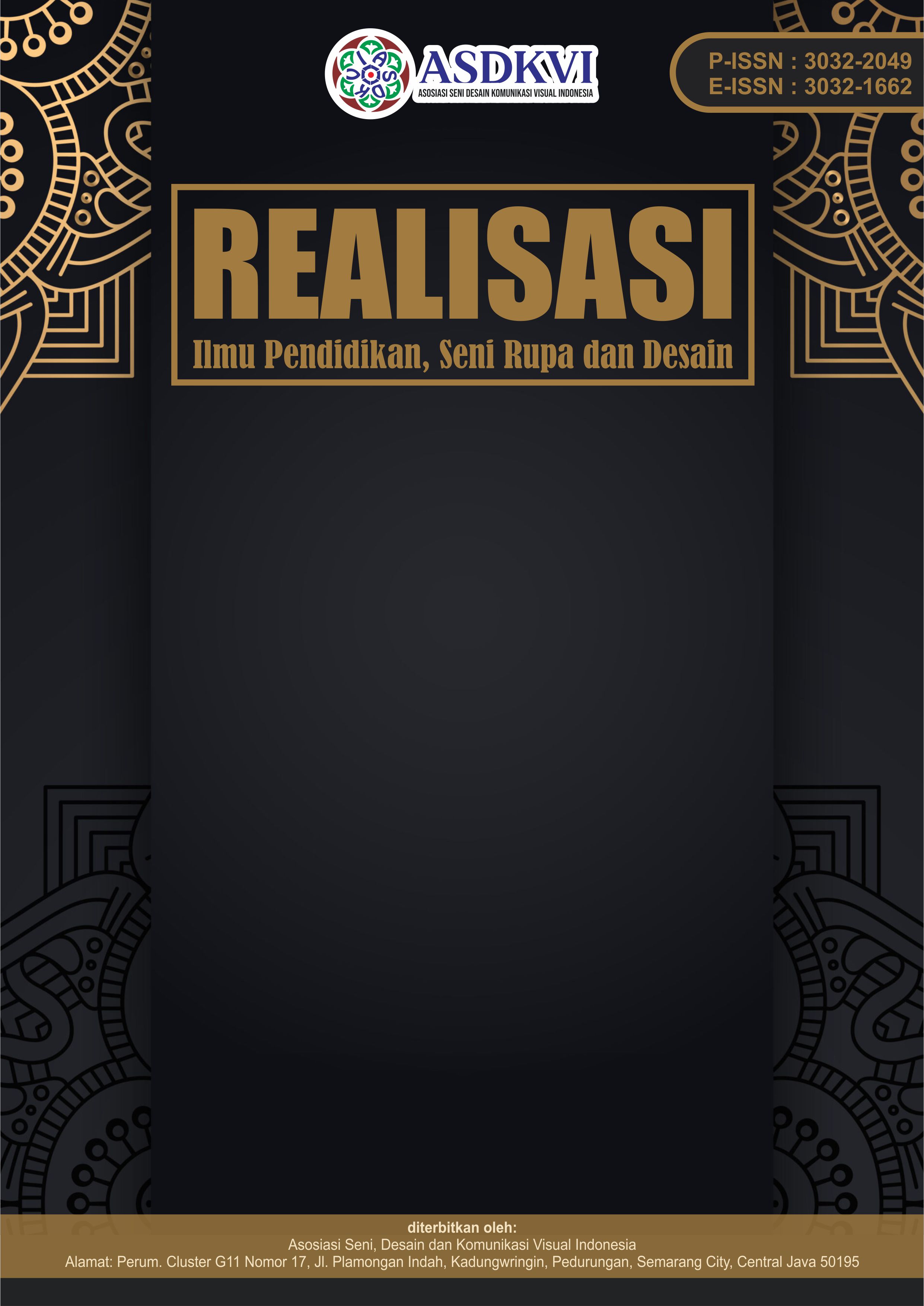Tanaman Kecombrang sebagai Ide Dasar Penciptaan Motif Batik Tulis
DOI:
https://doi.org/10.62383/realisasi.v2i3.736Keywords:
Creation, Torch Ginger Plants, Written BatikAbstract
Indonesian National Arts are different from other countries. One of them is textile craft art, which includes batik craft art, which was recognized by UNESCO as an original Indonesian cultural heritage on October 2, 2009. Batik is the art of drawing on clot . Hand-drawn batik is batik that is produced using a canting tulis which is used as a tool in placing wax liquid on the cloth. To create this work, the author uses the creation method from Sp. Gustami which consists of 3 stages, namely: Exploration, Design, and Realization. The results of the creation of this hand-drawn batik work produced 12 batik works in the form of two-dimensional works of various sizes. The types produced from this work are: Hijab, Long Cloth and Wall Decorations. Batik works have aesthetic value (beauty) namely the combination of Torch Ginger Plants. Torch Ginger Plants are used as the main motif in this batik work and other motifs are isen-isen. The process of creating written batik works that begins with the initial steps of making motifs on paper, transferring patterns from paper to cloth, the canting process, coloring batik, locking colors, and ngelorod batik. The process of creating written batik works that begins with the initial steps of making motifs on paper, transferring patterns from paper to cloth, the canting process, coloring batik, locking colors, and ngelorod batik.
References
Buku
Atmojo, W. T., & dkk. (2020). Batik: Eksplorasi kearifan lokal: Ornamen Sulawesi Utara. Medan: CV Kencana Emas Sejahtera.
Dofa, A. (1996). Batik Indonesia. Jakarta: PT Golden Terayon Press.
Gustami, S. P. (2007). Butir-butir mutiara estetika Timur: Ide dasar penciptaan seni kriya Indonesia. Yogyakarta: Prasista.
Hamzuri. (1989). Batik klasik. Jakarta: Djambatan.
Harmoko, H. (1997). Indonesia indah: Batik. Jakarta: Yayasan Harapan Kita.
Prawira, N. (2018). Budaya batik Delrmayon. Bandung: PT Sarana Tutorial Sejahtera.
Riyanto, D. (1997). Proses batik. Solo: CV Anelka.
Sari, R. (2013). Keterampilan membatik untuk anak. Yogyakarta: Arcita.
Setiawati, P. (2008). Kupas tuntas teknik proses membatik. Yogyakarta: Absolute.
Soedarso. (1998). Seni lukis batik Indonesia. Yogyakarta: Taman Budaya Provinsi Daerah Istimewa Yogyakarta.
Sugito. (2020). Metode penelitian pendidikan seni rupa. Medan: Unimed Press.
Sunoto, Sri Rusdiati, & dkk. (2000). Membatik. Yogyakarta: UNY.
Tim BBKB. (2018). Pelunturan batik: Praktik dasar dan teknik batik praktis sehari-hari. Yogyakarta: Aandi Publisher.
Velldhuyzen, H. C. (1993). Batik Belanda 1840–1940: Dutch influence in batik from Java history and stories. Jakarta: Gaya Favorit Press.
Wulandari, A. (2011). Batik Nusantara: Makna filosofis, cara pembuatan, dan industri batik. Yogyakarta: CV Andi Offset.
Jurnal dan Disertasi
Andini, S. P. (2022). Bunga mawar sebagai motif batik selendang dan sarung Bundo Kanduang [Disertasi doktoral, Institut Seni Indonesia Yogyakarta].
Khoiriyah, I. (2018). Bawang merah sebagai ide dasar penciptaan motif batik untuk busana santai wanita dewasa. Jurnal Seni Rupa, (1), 25–36.
Muawanah, A., Djajanegara, I., Sa’duddin, A., & Sukandar, D. (2012). Penggunaan bunga kecombrang (Etlingera elatior) dalam proses formulasi permen jelly. Jurnal Kimia Valensi, 2(4).
Pasaribu, M. E., Wiratma, S., & Diningrat, R. B. S. N. (2025). Penciptaan dress lilit motif bunga Easter Lily dengan teknik batik tulis. Realisasi: Ilmu Pendidikan, Seni Rupa dan Desain, 2(2), 87–103.
Ramadhania, R. (2019). Ikan selar dan ikan layur sebagai sumber ide penciptaan motif batik. Jurnal Seni Rupa, (7), 76–82.
Sari, I. I. (2017). Bunga anggrek hitam sebagai ide penciptaan karya batik pada kain tenun ulap doyo [Disertasi doktoral, Institut Seni Indonesia Yogyakarta].
Sari, I. P., & dkk. (2022). Pengaruh substitusi bunga kecombrang (Etlingera elatior) terhadap kapasitas antioksidan cookies. Journal of Food Technology and Agroindustry, (4), 32–40.
Syarif, R. A., Sari, F., & Ahmad, A. R. (2015). Rimpang kecombrang (Etlingera elatior Jack.) sebagai sumber fenolik. Jurnal Fitofarmaka Indonesia, 2(2), 102–106.
Triyatno, A. (2018). Bunga anggrek sebagai ide dasar penciptaan motif batik busana wanita. Jurnal Seni Rupa, (3), 550–560.
Yakiyah, S. (2023). Bunga Rafflesia sebagai sumber ide penciptaan motif batik pada busana pesta [Disertasi doktoral, Institut Seni Indonesia (ISI) Surakarta].
Downloads
Published
How to Cite
Issue
Section
License
Copyright (c) 2025 Realisasi : Ilmu Pendidikan, Seni Rupa dan Desain

This work is licensed under a Creative Commons Attribution-ShareAlike 4.0 International License.





